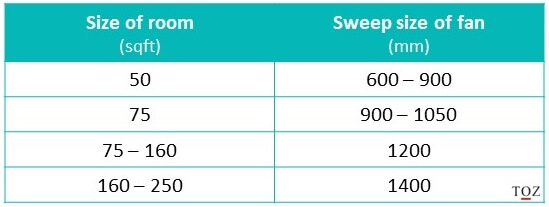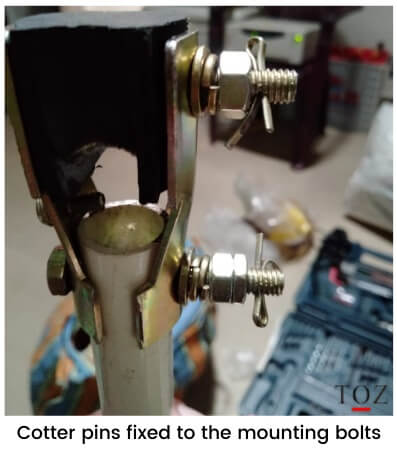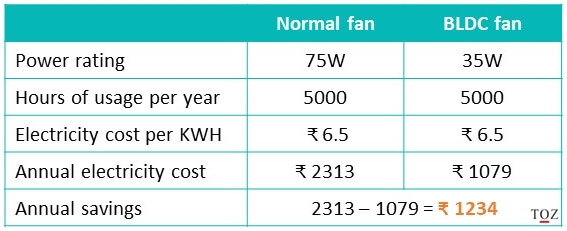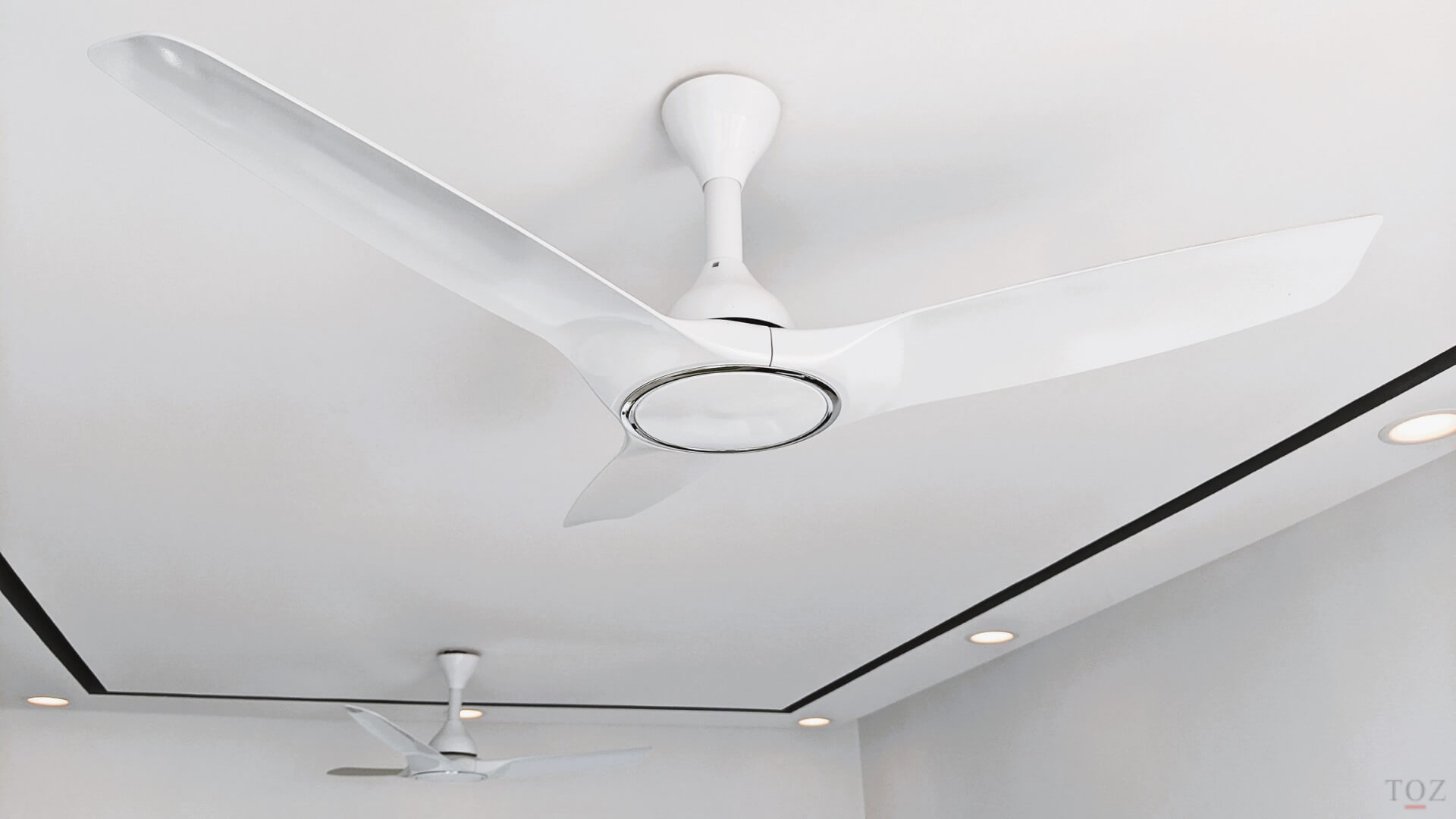1. Introduction
The ceiling fan is probably among the most neglected items when it comes to interior design; often purchased without giving much thought. Nevertheless, it’s an important fixture and a good assessment before purchasing it can go a long way in making us comfortable everyday and also saving money in the long run.
This post explores 2 areas:
- 10 factors to keep in mind when choosing a ceiling fan
- BLDC fans vs normal fans
2. 10 factors to keep in mind when choosing a ceiling fan
2.1 Sweep size (or size of the fan)
This basically refers to the diameter of the circle the fan makes when running. While sweep sizes vary from 600mm (24 inches) to 1400mm (56 inches), the most common sweep size in India is 1200mm (48 inches). The size of the fan primarily depends on the size of your room. Here’s a thumb rule to follow when deciding on the size:

While selecting the size, keep in mind that there should be sufficient distance between the edge of the blades and the walls, so as to ensure good circulation. Though a distance of 3 feet is recommended, you can go lower but make sure it doesn’t go below 1.5 feet.
In case you have a slightly longish room, it might make more sense to have 2 smaller fans instead of one large fan. This would ensure better coverage.
2.2 Air delivery
This is volume of air the fan delivers and is generally measured in CMM. (cubic metre per minute). While you would want a fan with a higher air delivery, it’s important to note the speed at which it delivers – higher the speed, more the noise. Speed is generally mentioned in RPM (rotations per min). So 2 fans may have the same air delivery, but the one with the lower speed would be less noisy. It’s important to look at both these factors in tandem when selecting between models.
2.3 Number of blades
Fans with lower number of blades take up less power, run faster and are consequently noisier. The high wind-chill created due to the high speed of the fan is known to lead to skin dryness and mild bodyache for some, especially when the fan is used overnight at higher speeds. Fans with higher no. of blades on the other hand, consume more power but don’t cause these issues. They circulate more air at lower speeds, thereby making them less noisy. The difference is similar to air flow from a pedestal fan versus a gentle breeze in a garden.
2.4 Noise levels
Apart from the noise created by the blades of the fan cutting through the air, the fan motor itself also makes a soft humming sound. This becomes particularly clear when you are working alone in a room or speaking over a call. BLDC fans are silent and are therefore better suited for rooms where you need a quiet environment like a study room, bedroom or home office. I’ll explain BLDC fans in more detail later in this post.
2.5 Downrod
Fans typically come with a downrod which is used to hang them from the ceiling. This length of this rod is specific to each fan (typically 12inches) and ensures there is enough space for air circulation from top. In case, you have a false ceiling, you need to buy a longer downrod to ensure that the distance from the ceiling is maintained. So if your fan uses a 12inch downrod and your false ceiling is 6inches in height, you need a new downrod of 18inches. Downrods are standard across brands, so in case the manufacturer doesn’t have the size, you can buy a generic one from any electrical store.

2.6 Ease of cleaning
Fans come in a wide variety of designs. When selecting designs, keep an eye out for how much dust the fan would collect. Fans with intricate designs are prone to collect dust in nooks and corners, and can be a pain to clean.
2.7 Fan with remote control
2.7.1 Do you need one?
Though remote-controlled fans have become fairly common now, don’t blindly buy one. It is important to look at each room individually and assess if it at all makes sense to buy a fan with a remote. If the fan regulator is easily accessible – right beside the bed, or study table, then it makes little sense to buy a fan with a remote control. On one hand remotes do add a lot of convenience, but on the other it is another remote added to the many remotes we already have at home. All BLDC fans come with remote control by default, though there are a few models that can work with a wall regulator. Brands have also started offering some regular fan models that can be controlled via a remote.
2.7.2 IR remote vs RF remote vs App
In case you opt for a fan with a remote control, check on the type of remote. IR (Infrared) remotes need you to explicitly point at the fan to control it, while RF (radiofrequency) remotes can be pointed at any direction in the room. It’s also better to buy a fan where the same remote can be used for multiple fans, so in case you misplace one remote or the batteries have run out, you can use the other one in the interim. If you have 2 fans in the same room, a single RF remote can control both together. However, if you want to control both the fans individually then it’s better to opt for fans with IR remotes, so you can point the remote at the particular fan you want to control. Alternately, you could buy a model where each fan has a dedicated remote, but then you’d be stuck if you misplace the remote or the battery runs out.
Some remote controls allow you to change the speed of the fan automatically after a few hours. This can be useful if your room gets cold early morning.
Smart fans or IoT (Internet of things) fans, can be controlled via a mobile app. The have many features, but you are stuck if the internet is down. Moreover, given how dependent we already are on phones and the amount of time we spend on it, the last thing you might want is an additional reason to use the phone. In fact, I completely disregarded smart fans for my house. However, if you are not averse to the idea to using the phone for controlling your fan, then you can consider smart fans.
Personal experience:
Some fans have an option of reversing the direction of rotation; wherein the air reaches you indirectly from the sides. I bought such a fan for my bedroom and found it particularly helpful during winters, when I don’t want direct air from the fan, but there is still good air-circulation in the room.
2.8 Coatings (anti-dust, anti-rust)
You will find brands boasting of different coatings like anti-rust, anti-dust etc. I think it’s more of a marketing gimmick and the premium you pay for these coatings is simply not worth it. A good coat of paint is enough to prevent rust, as we’ve seen over the years. Anti-dust coatings do not completely prevent dust from sticking to the fan, so you still need to clean them regularly.
2.9 Installation
Installing the fan correctly on the ceiling is critical as any error can lead to imbalance and recurring noises. If you hear a recurring ticking sound right after or in a few days after installation, chances are that the fan was not installed correctly. This is something most people don’t realise and blame the quality of the fan instead. So make sure you get a qualified electrician to install it, and if you hear any noise, have it corrected in a couple of days before it leads to further imbalance and damages in the fan. BLDC fans need specialised skills, so the companies generally send their own technicians for installing them.
2.9.1 Cotter pin – a key safety component

I specifically touch upon the topic of the cotter pin, since it’s a very important safety component that many electricians tend to overlook during installation. The reason ceiling fans rarely fall off the ceiling is because the mounts used for fixing the fans are very sturdy and reliable. However, all fan companies, without exception, provide a fail-safe component called a cotter pin. The cotter pin is a tiny, U-shaped piece of metal (looks similar to a hair-clip) that is fixed on the mounting bolt and provides a second level protection by preventing the nut from shifting laterally. All electricians know about this, but underestimate its importance and often skip fixing it. So make sure that the cotter pin is fixed for all your fans.
2.10 Fans with lights
Fans with lights make more sense if you don’t have enough natural or artificial lighting in the area. Else you could just skip it. However, if you looking at getting a fan with a light for decorative purposes, then there is a wide range available out there. They are more common in regular fans than the BLDC models.
3. BLDC fans vs normal fans
We generally don’t bother much about fan motors since, until a few years back, almost all of them used to use the same type of motor – a single phase induction motor. This is generally the normal or regular fan you will get in the market. But in the last few years more and more manufacturers have started using BLDC motors (brushless direct current motors) given its inherent benefits. BLDC motors as such are not new, in fact they have been around for years; they just were not used in ceiling fans. I won’t get into how these motors work; instead I will focus on its benefits so you can decide which one is best suited for different rooms in your house. BLDC fans have 4 key advantages over regular fans:
3.1 Higher efficiency, cost savings
BLDC fans are compact, lighter, generate lesser heat and use half the energy as that of regular fans. While a regular fan consumes an average of 75-80 watts, its BLDC counterpart would consume just 30-40 watts. As opposed to lights, that we normally switch on only in the evening, fans run much longer hours through the day. So the savings on using an efficient fan can be significant. Brands claim electricity cost savings of ₹ 1300-1500 per year. Here’s a conservative estimate of your annual savings per fan:

Your savings will be higher if you live in a city owing to the higher electricity costs there. BLDC fans are currently more expensive than regular fans, but you recover the additional cost in a year or two in terms of lower electricity bills. Post that, BLDC fans give you more savings. So while your upfront costs are high, you save in the long run.
3.2 Lower noise levels
By noise levels, I am not referring to the sound of the fan blade cutting through the air; that depends on blade design. Instead, I am referring to the constant hum that fans make when they are on, which can be quite loud and irritating in some regular fans. This hum is a quality of the single phase induction motor that normal fans use, so it can’t be reduced beyond a point. BLDC motors on the other hand are inherently very quiet since there’s no brush in a BLDC motor to physically rub against the coil. A quiet fan can be particularly helpful when you have to take evening meetings from home, recording audio or doing some activity that requires complete silence.
3.3 Accurate speed control
I am yet to come across a fan regulator that gives a smooth, linear control of fan speed, where the fan speed increases by the same amount at each level of the fan regulator. Most fan regulators have speed levels ranging from 1 to 5; put it on speed level 1 and it’s so slow that you are wondering why that level even exists. At level 2, the speed suddenly spikes, 3 and 4 are almost the same and then suddenly at level 5 it runs at full speed. And the difference between these speeds only gets worse with time. BLDC motors on the other hand, give a more accurate and smooth control over speed via remote control or app.
3.4 Immune to voltage fluctuations
The speed of a normal fan fluctuates with voltage. It’s quite common to see the fan running slower when running on inverter/generator. With BLDC motors, there is no such issue.
Given these benefits, it’s no surprise that all ceiling fan companies have increasingly started releasing more and more BLDC models. There was some hesitation initially since some BLDC fans had issues when used in coastal areas, but that got fixed subsequently. The only concern with a BLDC fan that I see is that, it requires some specialised skills to install it in your ceiling. So the local electrician may not know how to install it. To address this, many ceiling fan companies now send their own technicians to install the fan in your house.
4. Conclusion
A common approach followed by many is to select one model of fan and have that in every room. But given the alternatives I’ve outlined in this post, it might be well worth the effort to consider each room individually and select a fan that’s optimally suited to the needs of that room. It will take up some of your time, but it’s a one-time activity and totally worth it.
Have questions or queries?
There are some pertinent queries that other readers have asked in the comments section at the end of this page; do go through them to see if any of them resonate with you. If you have a different question, feel free to mention it there; I will do my best to answer it. Please allow a few days for me to respond. If I (or any other reader) can answer it, then good. If not, atleast it will be something for the next reader to keep in mind. In case you have any learnings or experience to share, do mention it there for the benefit of other readers.
In case you are considering exhaust fans…
While on the topic of ceiling fans, you might also be considering exhaust fans for your kitchen. I have covered kitchen exhaust fans in a separate post on kitchen appliances where I have written about how to select a chimney, hob and exhaust fan for your kitchen.
As home lighting is an extensive subject, I have written a dedicated post on this topic where I look at lighting layers, wattage, placement, colour temperature, smart lighting and lighting effects. If you are interested, you can check out my practical guide to home lighting design.
If you are looking to do up other parts of your house, you could refer my posts on:
- 4 factors to consider when designing or selecting a wardrobe – this delves into factors like build material options, pros and cons of different types of shutters, designing wardrobe internals (shelves, drawers, fittings), buying readymade versus getting it custom-made.
- How to select a bed that’s right for you – Build material options, pros and cons of different types of shutters, designing wardrobe internals, buying readymade versus getting it custom-made.
- A practical guide to planning your kitchen design – This explores design and material considerations for cabinets, drawers, shutters, countertop, splashback, fittings, sink and lighting. It also details out a structured approach to designing your kitchen.
Share this post:






I wanted to buy ceiling fans for all the rooms. I am looking for a basic fan thats durable. BLDC fans are too expensive to invest considering that we arent going to use them continuously throughout the year thanks to the pleasant weather. Nor would I benefit from the lower electricity bills. Anything specific I should look out for when buying the fans?
Yes, BLDC fans are more expensive as of now and if your usage is low, you can opt for the traditional single phase induction motor fans instead of the BLDC ones. Just keep these 3 considerations in mind when buying the fan:
1) Since the weather is pleasant in your area, you need not go for fans with the highest air-delivery as you would rarely have the need. You could save some money there.
2) If you have frequent power outages or voltage fluctuations in your area, try to select a model that has a better capacitor; they ensure better longevity of your fan. These models will typically have names that convey durability, long-life, endurance or something along those lines.
3) Fans with a copper winding are better than aluminium ones in terms of efficiency and handling temperature variations. The salesperson will be able to tell you which ones have it. Manufacturers usually mention it on the box if they use copper windings.
Thank you Pradip. Coming from Europe, this article is really very helpful – specially the correlation between fan and room size (maybe obvious to you, but was not known to me). Thank you!
Thanks Vojtech. Even though this mapping has been around for a while, I learnt about it only last year.
Thank you Pradip for this article, really helped me to identify what factors I should exactly be looking at.
Thanks Hiten 🙂
as such my room is 8ft by 10ft but fan hook is not in centre of the room and hence we buy 56”fan instead of 48” fan. Is that ok or there are disadvantage specially in terms of air circulation?
Hi Dipak,
The edge of the blade should be atleast 1.5 feet from the wall, so I hope the installation point is at the centre of the 8ft wall.
A 56″ fan would be too big for the room and there may be air turbulence issue at higher speeds, so I wouldn’t recommend a 56″ fan.
I see 2 options in your case:
1) One option would be to install 2 smaller fans, but that can be costly and a hassle to install.
2) The other would be to shift the installation point to the centre of the room. It’s a one-time exercise but better in the longer term. I had a similar situation when we reconfigured the bedroom and the bed was too far from the fan. It was a little civil work, but worked out well for us.